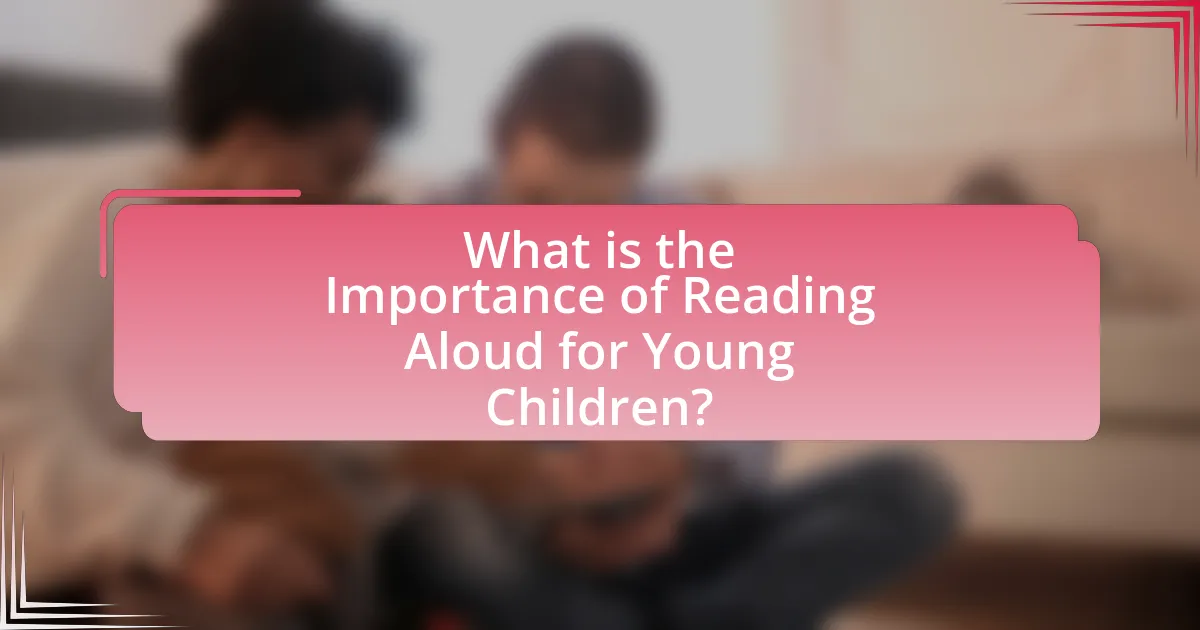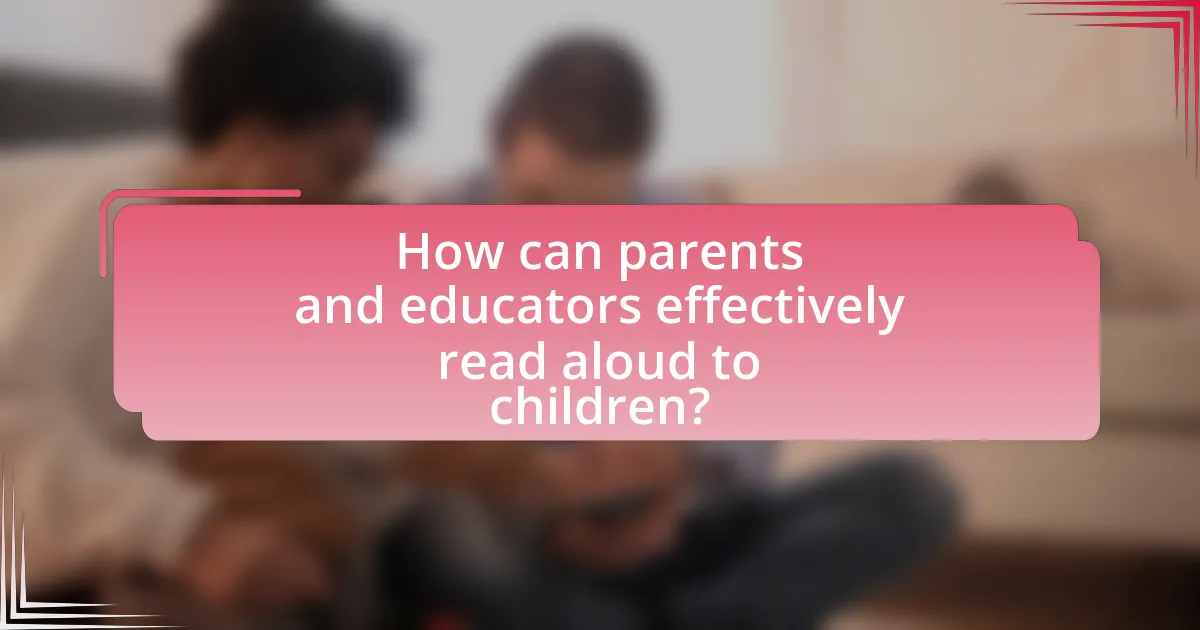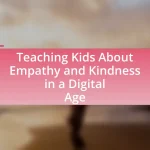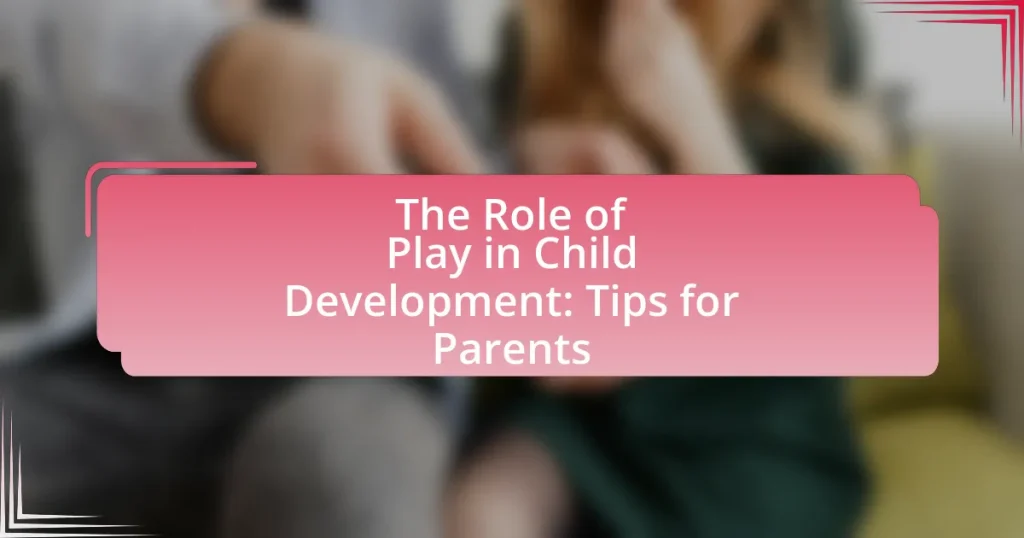The article emphasizes the critical role of reading aloud in enhancing language skills among young children. It outlines how this practice contributes to vocabulary acquisition, comprehension, listening skills, and cognitive development, supported by various research studies. Additionally, the article discusses the emotional and social benefits of reading aloud, including strengthening the parent-child bond and fostering social skills. It also provides practical strategies for parents and educators to effectively engage children during reading sessions, address common challenges, and utilize available resources to promote a love for reading.

What is the Importance of Reading Aloud for Young Children?
Reading aloud is crucial for young children as it significantly enhances their language development and literacy skills. When adults read to children, it exposes them to new vocabulary, sentence structures, and concepts, which are essential for effective communication. Research indicates that children who are read to regularly demonstrate improved language skills, including a larger vocabulary and better comprehension abilities. For instance, a study published in the journal “Child Development” by Mol and Bus (2011) found that reading aloud positively influences children’s language acquisition and literacy outcomes. This practice not only fosters a love for reading but also strengthens the bond between the reader and the child, creating a supportive learning environment.
Why is reading aloud considered essential for language development?
Reading aloud is essential for language development because it enhances vocabulary acquisition and comprehension skills in young children. When adults read aloud, they expose children to a richer language environment, introducing new words and phrases that children may not encounter in everyday conversation. Research indicates that children who are regularly read to develop larger vocabularies and better understanding of language structure. For instance, a study published in the journal “Child Development” by Sénéchal and LeFevre (2002) found that children who were read to frequently showed significant improvements in vocabulary and literacy skills compared to those who were not. This evidence underscores the critical role of reading aloud in fostering language development.
How does reading aloud influence vocabulary acquisition?
Reading aloud significantly enhances vocabulary acquisition by exposing listeners to a broader range of words and contexts than they might encounter in everyday conversation. This exposure facilitates the understanding of new vocabulary through context, pronunciation, and usage, which are critical for effective language development. Research indicates that children who are read to regularly demonstrate a larger vocabulary and improved comprehension skills compared to those who are not. For instance, a study by the National Institute for Literacy found that children who engage in reading aloud with caregivers develop vocabulary skills at a faster rate, leading to better academic performance in later years.
What role does reading aloud play in developing listening skills?
Reading aloud plays a crucial role in developing listening skills by enhancing auditory processing and comprehension. When children listen to stories read aloud, they are exposed to varied vocabulary, sentence structures, and narrative styles, which helps them understand spoken language better. Research indicates that children who are regularly read to exhibit improved listening abilities, as they learn to focus on the speaker and interpret sounds and meanings. A study published in the Journal of Educational Psychology found that children who engaged in shared reading showed significant gains in listening comprehension compared to those who did not participate in such activities. This evidence underscores the importance of reading aloud in fostering essential listening skills in young children.
How does reading aloud impact cognitive development in young children?
Reading aloud significantly enhances cognitive development in young children by improving their language skills, comprehension, and critical thinking abilities. Engaging in shared reading experiences fosters vocabulary expansion and helps children understand narrative structures, which are crucial for effective communication. Research indicates that children who are read to regularly exhibit higher levels of literacy skills and cognitive abilities compared to those who are not. For instance, a study published in the journal “Child Development” by Bus, van Ijzendoorn, and Pellegrini found that reading aloud positively correlates with children’s language development and academic success, demonstrating the long-term benefits of this practice.
What are the effects of reading aloud on comprehension skills?
Reading aloud significantly enhances comprehension skills in children. This practice improves vocabulary acquisition, listening skills, and the ability to make inferences, which are crucial for understanding texts. Research by the National Institute for Literacy indicates that children who are read to regularly demonstrate better comprehension abilities compared to those who are not. Additionally, a study published in the Journal of Educational Psychology found that reading aloud fosters a deeper engagement with the text, allowing children to connect ideas and themes more effectively. These findings underscore the importance of reading aloud as a vital tool for developing strong comprehension skills in young learners.
How does reading aloud foster critical thinking in children?
Reading aloud fosters critical thinking in children by encouraging them to engage with the text, ask questions, and make connections. When children listen to stories, they are prompted to think about characters’ motivations, predict outcomes, and analyze the plot, which enhances their ability to reason and evaluate information. Research indicates that interactive reading sessions, where adults ask open-ended questions, significantly improve children’s critical thinking skills. For example, a study published in the Journal of Educational Psychology found that children who participated in dialogic reading showed greater gains in critical thinking compared to those who experienced traditional reading methods. This interaction not only develops comprehension but also nurtures a habit of inquiry, essential for critical thinking.
What emotional and social benefits does reading aloud provide?
Reading aloud provides significant emotional and social benefits, including enhanced bonding between the reader and listener, improved emotional intelligence, and increased social interaction. When adults read to children, it fosters a sense of security and attachment, which is crucial for emotional development. Research indicates that shared reading experiences can lead to better communication skills and empathy, as children learn to understand different perspectives through stories. Additionally, reading aloud in group settings promotes social skills, such as cooperation and sharing, as children engage with peers during discussions about the content. These interactions contribute to a supportive learning environment, reinforcing the importance of social connections in early childhood development.
How does reading aloud strengthen the parent-child bond?
Reading aloud strengthens the parent-child bond by fostering emotional connection and enhancing communication. When parents read to their children, they create a shared experience that promotes intimacy and trust, as the child feels valued and engaged. Research indicates that this interaction not only improves language skills but also encourages children to express their thoughts and feelings, further deepening the relationship. For instance, a study published in the journal “Child Development” found that children who are read to regularly exhibit stronger attachment to their parents, highlighting the significance of this activity in building a secure emotional foundation.
What social skills can children develop through shared reading experiences?
Children can develop several social skills through shared reading experiences, including communication, empathy, and cooperation. During shared reading, children learn to express their thoughts and feelings about the story, enhancing their verbal communication skills. Additionally, discussing characters’ emotions and actions fosters empathy, as children begin to understand different perspectives. Furthermore, engaging in turn-taking while reading or discussing the book promotes cooperation and patience, essential components of social interaction. Research indicates that these interactions during shared reading significantly contribute to children’s social development, as they learn to navigate social cues and build relationships with peers and adults.

How can parents and educators effectively read aloud to children?
Parents and educators can effectively read aloud to children by using expressive voice modulation, engaging with the text through questions, and incorporating interactive elements. Expressive reading captures children’s attention and enhances their understanding of emotions and character motivations, which research shows improves comprehension skills. Engaging children with questions about the story encourages critical thinking and active participation, fostering a deeper connection to the material. Additionally, incorporating interactive elements, such as asking children to predict outcomes or relate the story to their own experiences, further enhances their language development and retention of information. Studies indicate that these strategies significantly boost vocabulary acquisition and listening skills in young children, making reading aloud a vital practice in early education.
What techniques can enhance the reading aloud experience?
Techniques that can enhance the reading aloud experience include using expressive intonation, engaging with the audience through eye contact, and incorporating gestures. Expressive intonation captures attention and conveys emotions, making the story more engaging; research shows that children respond better to varied vocal tones, which aids in comprehension and retention. Engaging with the audience through eye contact fosters a connection, encouraging participation and interest. Incorporating gestures can illustrate key points and enhance understanding, as studies indicate that physical movement during storytelling can improve memory retention in young listeners.
How can tone and expression affect a child’s engagement during reading?
Tone and expression significantly enhance a child’s engagement during reading by making the narrative more relatable and stimulating. When a reader uses varied tones and expressive language, it captures the child’s attention and fosters emotional connections to the story. Research indicates that children are more likely to remember and comprehend stories when they are read with enthusiasm and appropriate emotional cues, as these elements help convey the mood and intent of the text. For instance, a study published in the Journal of Educational Psychology found that expressive reading can improve children’s recall and understanding of story elements, demonstrating the direct impact of tone and expression on engagement levels.
What strategies can be used to choose appropriate books for different ages?
To choose appropriate books for different ages, one effective strategy is to consider developmental milestones and interests of each age group. For instance, infants benefit from board books with simple images and textures, while toddlers enjoy interactive stories that encourage participation. Preschoolers are ready for more complex narratives that introduce basic concepts, and early elementary children can handle chapter books that feature relatable characters and themes. Research indicates that matching books to a child’s developmental stage enhances comprehension and engagement, as seen in studies by the American Academy of Pediatrics, which emphasize the importance of age-appropriate content in fostering language skills.
How can interactive reading improve language skills?
Interactive reading enhances language skills by actively engaging children in the reading process, which promotes vocabulary acquisition, comprehension, and critical thinking. During interactive reading sessions, children are encouraged to ask questions, make predictions, and discuss the story, which fosters deeper understanding and retention of language concepts. Research indicates that children who participate in interactive reading demonstrate improved language outcomes, such as a 30% increase in vocabulary and a 20% improvement in comprehension skills compared to those who experience traditional reading methods. This engagement not only builds language proficiency but also cultivates a love for reading, further supporting language development.
What questions should parents ask during reading to promote discussion?
Parents should ask open-ended questions during reading to promote discussion, such as “What do you think will happen next?” or “How do you feel about the character’s decision?” These types of questions encourage children to think critically and express their thoughts, enhancing their comprehension and engagement with the text. Research indicates that asking open-ended questions fosters deeper conversations and supports language development, as it requires children to articulate their ideas and reasoning.
How can parents incorporate activities related to the story to enhance understanding?
Parents can incorporate activities such as discussions, role-playing, and creative projects related to the story to enhance understanding. Engaging in discussions about the plot, characters, and themes allows children to articulate their thoughts and deepen comprehension. Role-playing scenes from the story encourages children to explore character motivations and emotions, fostering empathy and critical thinking. Creative projects, such as drawing scenes or writing alternative endings, stimulate imagination and reinforce narrative structure. Research indicates that interactive reading strategies, including these activities, significantly improve language skills and comprehension in young children, as highlighted in the National Reading Panel’s report on effective reading instruction.

What are the challenges and solutions related to reading aloud?
Reading aloud presents challenges such as lack of engagement, difficulty in pronunciation, and limited vocabulary exposure. To address these issues, educators and parents can implement interactive reading strategies, utilize phonics-based approaches, and introduce diverse literature to enhance vocabulary. Research indicates that interactive reading, where children participate in discussions about the text, significantly improves comprehension and interest (Whitehurst & Lonigan, 1998). Additionally, using phonics instruction helps children decode words more effectively, leading to better pronunciation and fluency. By incorporating these solutions, the benefits of reading aloud can be maximized, fostering language development in young children.
What common obstacles do parents face when reading aloud?
Parents commonly face obstacles such as lack of time, distractions, and difficulty engaging their children when reading aloud. The busy schedules of parents often limit the time available for reading sessions, making it challenging to establish a routine. Distractions from electronic devices or other activities can interrupt the reading experience, reducing its effectiveness. Additionally, parents may struggle to maintain their children’s interest, especially if the material does not resonate with them, which can hinder the development of language skills. Research indicates that consistent reading aloud is crucial for language acquisition, highlighting the importance of overcoming these obstacles to foster literacy in young children.
How can busy schedules impact the frequency of reading aloud?
Busy schedules can significantly reduce the frequency of reading aloud, as time constraints limit opportunities for this activity. Research indicates that parents and caregivers often prioritize other responsibilities, leading to less engagement in reading aloud, which is crucial for language development in young children. A study by the American Academy of Pediatrics found that reading aloud to children enhances vocabulary and comprehension skills, but busy lifestyles can hinder this practice, resulting in missed developmental benefits.
What strategies can help overcome children’s resistance to reading aloud?
To overcome children’s resistance to reading aloud, engaging them through interactive and enjoyable methods is essential. Strategies include selecting books that align with their interests, incorporating visual aids, and using expressive reading techniques to make the experience more captivating. Research indicates that children are more likely to participate in reading activities when they find the material relatable and entertaining, as highlighted in a study by the National Reading Panel, which emphasizes the importance of motivation in literacy development. Additionally, creating a supportive environment where mistakes are viewed as part of the learning process can further encourage children to read aloud without fear of judgment.
What resources are available to support reading aloud practices?
Resources available to support reading aloud practices include children’s literature, educational websites, and community programs. Children’s literature provides a diverse range of engaging stories that can captivate young audiences and enhance their language skills. Educational websites, such as Read Aloud.org, offer resources like book recommendations, reading strategies, and tips for effective reading aloud. Community programs, including library storytime sessions, provide opportunities for children to experience reading aloud in a social setting, fostering a love for books and improving literacy skills. These resources collectively contribute to the development of language skills in young children through interactive and enjoyable reading experiences.
How can libraries and community programs assist in promoting reading aloud?
Libraries and community programs can promote reading aloud by organizing interactive storytelling sessions and providing resources that encourage family participation. These programs often feature trained facilitators who engage children through dynamic reading experiences, which have been shown to enhance language development and literacy skills. For instance, a study by the National Institute for Literacy indicates that children who participate in reading aloud activities demonstrate improved vocabulary and comprehension skills. Additionally, libraries can offer access to a diverse range of books and materials that cater to various age groups and interests, further motivating families to read together.
What online tools and apps can aid parents in reading aloud effectively?
Online tools and apps that aid parents in reading aloud effectively include Storyline Online, Audible, and Epic. Storyline Online features videos of actors reading children’s books, enhancing engagement and comprehension. Audible offers a vast library of audiobooks, allowing parents to listen to stories while following along with the text, which supports language development. Epic provides access to thousands of books and read-aloud features, making it easier for parents to share stories with their children. These resources are designed to foster a love for reading and improve language skills in young children.
What are some best practices for incorporating reading aloud into daily routines?
Incorporating reading aloud into daily routines can be effectively achieved by setting a specific time each day dedicated to this activity. Establishing a consistent schedule, such as reading before bedtime or during breakfast, helps create a habit that children can anticipate and enjoy. Research indicates that regular reading aloud enhances vocabulary and comprehension skills, with studies showing that children who are read to frequently develop stronger language abilities. Additionally, selecting a variety of engaging and age-appropriate books can maintain children’s interest and stimulate their imagination, further reinforcing the benefits of reading aloud.















